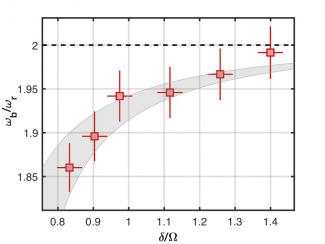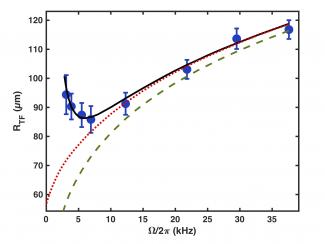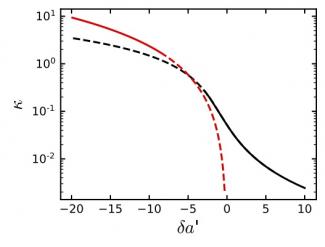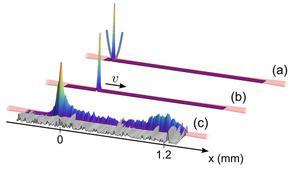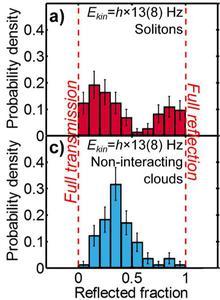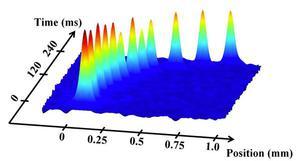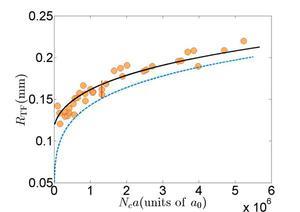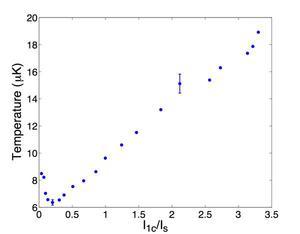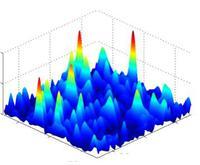Quantum Gases with Tunable Interactions
Quantum Gases with Tunable Interactions
Permanent staff: Thomas Bourdel (contact), Alain Aspect
PhDs: Roy Eid, Sara Tiengo, Maé Lévy
If you are interested in our research, do not hesitate contact us. We offer positions at all levels.
In particular, we are looking for a M2 student who could continue for a PhD thesis in 2026.
Our Research
We especially study gases in reduce dimensions (1D, 2D), where quantum and thermal fluctuations are most important. Importantly, we work with potassium 39, a bosonic element having nice magnetically tunable Feshbach resonances, thus permitting the control of the interatomic interaction. We have changed the experimental setup, replacing the stainless steel science chamber with a small glass cell (click to see a video). This setup permits the production of condensates every 6-7 seconds and it allows for high numerical aperture imaging, fast change of the magnetic field and easy RF transfers between spin states, thus allowing quenches of the interaction parameters. This new setup is especially suitable for the study of RF coherent dressing which permits to not only control two body but also three-body interactions.
Some results
Three-body interactions in Rabi coupled Bose gases: a perturbative approach
|
Feyman diagrams corresponding to the higher order interaction giving rise to the three-body interaction. The solid (dashed) line corresponds to the lower (higher dressed state) |
In this paper, we theoretically prove that higher order interaction with virtual intermediate states lead to three-body interactions when the Hilbert space is reduced to a single spin state. We recover previous equation of state results in either mean-field or beyond mean-field framework. |
Magnetic field stabilisation for Bose-Einstein condensation experiments
|
Schematic of the stabilization system. In essence, it is a feedforward technique in a separated coil. A key feature is that the mutual inductance between the two circuits is cancelled. |
We show a stability at the ppm level for a magnetic field around 55 Gauss. It allows a fine control of the radio-frequency dressing that we use to control the atom interaction. |
Quantum tunnelling through single and double optical barriers
|
Transmission through two barriers as a function of the distance between them. The observed modulation is a combined effect of optical interference between the two barriers and of atom Fabry-Pérot type interference. |
We realize textbook experiments on Bose-Einstein condensate tunnelling through thin repulsive potential barriers. In particular, we demonstrate atom tunnelling though a single optical barrier in the quantum scattering regime where the De Broglie wavelength of the atoms is larger than the barrier width. Such a beam splitter can be used for atom interferometry and we study the case of two barriers creating an atomic Fabry-Pérot cavity. The potential barriers are created optically and their width is tunable thanks to the use of a digital micro-mirror device. |
Tunable 3-body interactions in coherently driven two-component Bose-Einstein condensate
|
Radial breathing frequency as a function of dressing radiofrequency detuning. The down shift is a clear indication of the presence of attractive three-body interaction. |
We theoretically and experimentally study the appearance of an attractive three-body term in the equation of state of a coherently-driven two-component Bose Einstein condensate. This term originates from a mean-field shift of the drive detuning. We show that it can play an important role especially when the two-body term is tuned close to a zero crossing. Experimentally, we show two striking consequences of the effective attractive three-body term in a cigar-shaped trap. First, we demonstrate the shift of radial breathing mode frequency, although it is insensitive to two-body interactions. Second, we show that the radial collapse of the condensate can happen for positive values of the scattering length. In both experiment, we study the effect as a function of the Rabi-coupling strength which permits to control the magnitude of the three-body term. |
Beyond-mean-field effects in Rabi-coupled two-component Bose-Einstein condensate
|
Condensate size after an expansion in the 1D geometry. The expansion is governed by the beyond-mean-field energy. |
We have studied, in collaboration with D. Petrov and A. Recati, the equation of state of Rabi-coupled two component condensate mixture in the specific case where mean-field interaction vanishes and where it is solely given by beyond-mean-field effects. Experimentally, the beyond-mean-field energy is measured in an expansion experiment. From its dependance as a function of the coupling strength, we are able to detect not only the dominant 2-body term but also the sub-leading 3-body term. |
1D to 3D beyond-mean-field dimensional crossover in mixture quantum droplets
|
Dimensionless density in a bulk quantum droplet as a function of the mean-field parameter. The black (resp. red) curve corresponds to the 1D-3D crossover (resp. 3D) beyond-mean-field model. The curves are dashed in the regions where the theory is expected not to be valid. |
We have study quantum droplets originating from the interplay between mean-field and beyond-mean-field contributions to the equation of state in the crossover from 1D to 3D. Amazingly, we find the quantum droplets exist both for negative and positive values of the scattering length due to a change of sign of the beyond-mean-field energy from 1D to 3D. The crossover regime appears to offer a good compromise for future experimental studies. |
Observation of the algebraic localization delocalization transition in a 1D disordered potential with a bias force
|
Schematic of the experimental sequence. A non-interactiing BEC is launched in a 1D speckle potential. At intermediate disorder strength, both localized and propagating atoms are observed. |
One-dimensional (1D) Anderson localization phenomena are strongly affected by a bias force, or equivalently a voltage in electronic systems. We experimentally study this case, launching a non-interacting $^{39}$K Bose-Einstein condensate in a 1D disordered potential induced by a far-off-resonance laser speckle, while controlling a bias force. In agreement with theoretical predictions, we observe a transition between algebraic localization and delocalization as a function of our control parameter that is the relative strength of the disorder against the bias force. We also demonstrate that the transition is intrinsically energy independent and that the initial velocity of the wave-packet only plays a role through an effective disorder strength due to the correlation of the disorder. |
Non-linear scattering of atomic bright solitons
|
Histograms of the reflected fraction of slow moving atoms in a disorder potential. a) atoms in a soliton. c) non-interacting atoms. |
We observe nonlinear scattering of 39K atomic bright solitons launched in a one-dimensional (1D) speckle disorder. We directly compare it with the scattering of non-interacting particles in the same disorder. The atoms in the soliton tend to be collectively either reflected or transmitted, in contrast with the behavior of independent particles, thus demonstrating a clear nonlinear effect in scattering. The observed strong fluctuations in the reflected fraction, between zero and 100%, are interpreted as a consequence of the strong sensitivity of the system to the experimental conditions and in particular to the soliton velocity. This behavior is reproduced in a mean-field framework by Gross-Pitaevskii simulations. |
Production of strongly bound 39K bright solitons
|
Propagation of 39K bright solitons. |
We report on the production of 39K matter-wave bright solitons, i.e., 1D matter-waves that propagate without dispersion thanks to attractive interactions. Our solitons, close to the collapse threshold, are strongly bound and will find applications in fundamental physics and atom interferometry. |
All-optical production of Bose-Einstein condensates with tunable interaction
|
Size of the condensate after expansion for a variable interaction parameter. |
We have achieved Bose-Einstein condensation of potassium 39 in an all-optical cooling scheme. It permits to reduce the duration of the experimental cycles to a few seconds. The interactions between atoms are controlled in order to optimize the collision rate during the evaporation and can then be tuned to any desirable value. As an example, we have studied the radial expansion of the gas from an elongated trap exploring the 1D to 3D crossover. |
Gray molasses cooling of 39K to a high phase-space density
|
Temperature of the D1 gray molasses as a function of the D1 cooling intensity per beam. |
We have developed new techniques in cooling 39K atoms using laser light close to the D1 transition. First, a new compressed-MOT configuration is taking advantage of gray molasses type cooling induced by blue-detuned D1 light. It yields an optimized density of atoms. Then, we use pure D1 gray molasses to further cool the atoms to an ultra-low temperature of 6 µK. The resulting phase-space density is 2x10-4 and will ease future experiments with ultracold potassium. As an example, we use it to directly load up to 3x107 atoms in a far detuned optical trap, a result that opens the way to the all-optical production of potassium degenerate gases. |
Effect of disorder close to the superfluid phase transition in a two-dimensional Bose gas
|
Typical example of a speckle disorder. The superfluid phase transition can be studied as a function of the disorder strength. |
We experimentally study the effect of disorder on trapped quasi two-dimensional (2D) 87Rb clouds in the vicinity of the Berezinskii-Kosterlitz-Thouless (BKT) phase transition. The disorder correlation length is of the order of the Bose gas characteristic length scales (thermal de Broglie wavelength, healing length) and disorder thus modifies the physics at a microscopic level. We analyze the coherence properties of the cloud through measurements of the momentum distributions, for two disorder strengths, as a function of its degeneracy. For moderate disorder, the emergence of coherence remains steep but is shifted to a lower entropy. In contrast, for strong disorder, the growth of coherence is hindered. Our study is an experimental realization of the dirty boson problem in a well controlled atomic system suitable for quantitative analysis. |
Coherence properties of a 2D trapped Bose gas around the superfluid transition
|
2D Momentum distribution for different atom number. The left image corresponds to a normal gas, the middle one to a gas at the superfluid transition and the right one to a gas deep in the superfluid phase. The shrinking of the momentum distribution is related to the increasing coherence in the 2D gas when crossing the BKT superfluid transition. |
We measure the momentum distribution of a 2D trapped Bose gas and observe the increase of the range of coherence around the Berezinskii-Kosterlitz-Thouless (BKT) transition. We quantitatively compare our observed profiles to both a Hartree-Fock mean-field theory and to quantum Monte-Carlo simulations. In the normal phase, the momentum distribution is observed to sharpen well before the phase transition. This behavior is partially captured in a mean-field approach, in contrast to the physics of the BKT transition. |
Publications
- R. Eid, S. Tiengo, M. Lévy, T. Bourdel, Saturating interaction in coherently coupled two component Bose-Einstein condensates, arXiv:2507.21849.
- S. Tiengo, R. Eid, T. Bourdel, Three-body interactions in Rabi-coupled Bose gases: a perturbative approach, Phys. Rev. A 111, 053319 (2025).
- S. Tiengo, R. Eid, M. Apfel, G. Brulin, T. Bourdel, A simple magnetic field stabilization technique for Bose-Einstein condensate experiements, Rev. Sci. Instrum. 96, 063201 (2025).
- R. Eid, A. Hammond, L. Lavoine, T. Bourdel Ultracold-atom quantum tunneling through single and double optical barriers, Phys. Rev. A 110, 043316 (2024).
- A. Hammond, L. Lavoine, T. Bourdel, Tunable 3-body interactions in coherently driven two-component Bose-Einstein condensate, Phys. Rev. Lett. 128, 083401 (2022).
- L. Lavoine, A. Hammond, A. Recati, D.S. Petrov, T. Bourdel, Beyond-mean-field effects in Rabi-coupled two-component Bose-Einstein condensate, Phys. Rev. Lett. 127, 203402 (2021).
- L. Lavoine, T. Bourdel, Beyond-mean-field crossover from one dimension to three dimensions in quantum droplets of binary mixtures, Phys. Rev. A 103, 033312 (2021).
- G. Berthet, L. Lavoine, M. Parit, A. Brolis, A. Boissé, T. Bourdel, Observation of the algebraic localization-delocalization transition in a 1D disordered potential with a bias force, arXiv:1908.01511, Phys. Rev. Research 2, 013386 (2020).
- A. Tenart, C. Carcy, H. Cayla, T. Bourdel, M. Mancini, D. Clément, Two-body collisions in the time-of-flight dynamics of lattice Bose superfluids, arXiv:1909.13648, Phys. Rev. Research 2, 013017 (2020).
- L. Fouché, A. Boissé, G. Berthet, S. Lepoutre, A. Simoni, and T. Bourdel, Quantitative analysis of losses close to a d-wave open-channel Feshbach resonance in 39K, Phys. Rev. A 99, 022701 (2019).
- A. Boissé, G. Berthet, L. Fouché, G. Salomon, A. Aspect, S. Lepoutre, T. Bourdel, Non-linear scattering of atomic bright solitons in disorder, EPL, 117 10007 (2017).
- S. Lepoutre, L. Fouché, A. Boissé, G. Berthet, G. Salomon, A. Aspect, and T. Bourdel, Production of strongly bound 39K bright solitons, PRA 94, 053626 (2016).
- G. Salomon, L. Fouché, S. Lepoutre, A. Aspect, and T. Bourdel, All-optical cooling of 39K to Bose-Einstein condensation, PRA 90, 033405 (2014).
- G. Salomon, L. Fouché, P. Wang, A. Aspect, P. Bouyer, T. Bourdel, Gray-molasses cooling of 39K to a high phase space density, EPL 104, 63002 (2014).
- T. Bourdel, Phase diagrams of 2D and 3D disordered Boses gases in the local density approxiamtion, Phys. Rev. A, 86, 063626 (2012).
- T. Plisson, T. Bourdel, C.A. Müller, Momentum isotropisation in random potential,Eur. Phys. J. Special Topics 217, 79 (2013).
- B. Allard, T. Plisson, M. Holzmann, G. Salomon, A. Aspect, P. Bouyer, T. Bourdel, Effect of disorder close to the superfluid phase transition in a two-dimensional Bose gas. Phys. Rev. A 85, 033602 (2012).
- T. Plisson, B. Allard, M. Holzmann, G. Salomon, A. Aspect, P. Bouyer, T. Bourdel, Coherence properties of a 2D trapped Bose gas around the superfluid transition, Phys. Rev. A 84, 061606(R) (2011).
- T. Bourdel, M. Robert-de-Saint-Vincent, J.-P. Brantut, Ch. J. Borde, A. Aspect, P. Bouyer,
Classical and quantum trampoline for ultra-cold atoms, in Quantum phenomena in gravitational field,
Comptes Rendus Physique 12, 779 ( 2011). - L. Pezze, M. Robert-de-Saint-Vincent, T. Bourdel, J.-P. Brantut, B. Allard, T. Plisson, A. Aspect, P. Bouyer, L. Sanchez-Palencia,
Regimes of classical transport of cold gases in a two-dimensional anisotropic disorder,
New Journal of Physics 13, 095015 (2011). - M. Robert-de-Saint-Vincent, J.-P. Brantut, B. Allard, T. Plisson, L. Pezzé, L. Sanchez-Palencia, A. Aspect, T. Bourdel, P. Bouyer
Anisotropic 2D diffusive expansion of ultra-cold atoms in a disordered potential
Phys. Rev. Lett. 104, 220602 (2010). - G. Stern, B. Allard, M. Robert-de-Saint-Vincent, J.-P. Brantut, B. Battelier, T. Bourdel, P. Bouyer
A frequency doubled 1534 nm laser system for potassium laser cooling
applied optics 49, 1 (2010). - M. Robert-de-Saint-Vincent, J.-P. Brantut, Ch.J. Bordé, A. Aspect, T. Bourdel and P. Bouyer
A quantum trampoline for ultra-cold atoms
EPL 89, 10002 (2010). - J.-F. Clément, J.-P. Brantut, M. Robert-de-Saint-Vincent, R. A. Nyman, A. Aspect, T. Bourdel, and P. Bouyer
All-optical runaway evaporation to Bose-Einstein condensation
Phys. Rev. A 79, 061406 (R) (2009) - J. P. Brantut, J. F. Clément, M. Robert de Saint Vincent, G. Varoquaux, R.A. Nyman, A. Aspect, T. Bourdel, and P. Bouyer
Light-shift tomography in an optical-dipole trap for neutral atoms
Phys. Rev. A 78, 031401(R) (2008) - G. Varoquaux, N. Zahzam, W. Chaibi, J.-F. Clément, O. Carraz, J.-P. Brantut, R.A. Nyman, F. Pereira Dos Santos, L. Mondin, M. Rouzé, Y. Bidel, A. Bresson, A. Landragin, P. Bouyer,
I.C.E.: An Ultra-Cold Atom Source for Long-Baseline Interferometric Inertial Sensors in Reduced Gravity,
eprint arXiv: 0705.2922, (2007) ; Rencontres de Moriond Gravitational Waves and Experimental Gravity - R.A. Nyman, G. Varoquaux, F. Lienhart, D. Chambon, S. Boussen, J.F. Clément, T. Müller, G. Santarelli, F. Pereira Dos Santos, A. Clairon, A. Bresson, A. Landragin, P. Bouyer,
I.C.E.: a transportable atomic inertial sensor for test in microgravity
Applied physics B 84, 673 (2006) - R. A. Nyman, G. Varoquaux, B. Villier, D. Sacchet, F. Moron, Y. Le Coq, A. Aspect, and P. Bouyer, Tapered-amplified AR-coated laser diodes for Potassium and Rubidium atomic-physics experiments
Review of Scientific Instruments 77, 033105 (2006)
Offers of Projects for Undergraduates, PhDs and Post-docs
If you are interested in our research, please do not hesitate to contact Thomas Bourdel. We have open positions for PhD or post-docs. We also offer to some motivated undergraduate students at various levels to work with us every year. See the link to a more detail thesis/intership proposition above.
Former members
- Alfred Hammond (PhD 2023), now looking for a job, France
- Lucas Lavoine (PhD 2022), now Post-doc in Stuttgart, Germany
- Guillaume Berthet (PhD 2019), now high school and bachelor professor, France
- Amaudric Boissé (PhD 2018), now high school professor, France
- Alessandro Brolis (Post-doc, 2018), now Engineer in Italy.
- Steven Lepoutre (post-doc 2015), now maître de conférence in LAC (Orsay), France
- Lauriane Fouché (PhD 2015), now engineer in CEA, Bordeaux, France
- Guillaume Salomon (PhD 2014), now researcher in Hamburg, Germany
- Philippe Bouyer, now coordinator of Quantum Delta in the Netherlands
- Pengjun Wang (post-doc 2013), now researcher at Shanxi university, Taiyuan, China
- Baptiste Allard (PhD 2012), now maitre de conférence in Toulouse, France
- Thomas Plisson (PhD 2012), now researcher in CEA, Saclay, France
- Martin Robert-de-saint-Vincent (2011); now CNRS researcher in LPL, Villetaneuse, France
- Jean-Philippe Brantut (PhD 2009), now professor in Lausanne (EPFL), Switzerland
- Jean-Francois clément (PhD 2008), now maitre de conférence in Phlam, Lille, France
- Robert Nyman (post-doc 2008), now research assistant in Imperial College, London, Great Britain
- Gael Varoquaux (PhD 2007) , now researcher in Neurospin, Saclay, France
Supports
- CNRS
- Université Paris Saclay
- ANR
- PEPR
- DIM Quantip
- PhOM
- Simons Collaboration on the localization of waves


